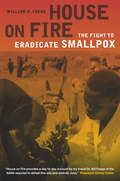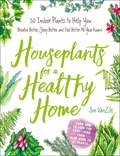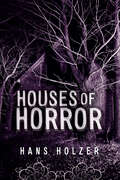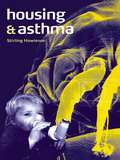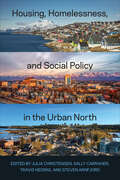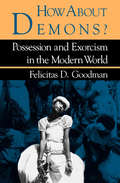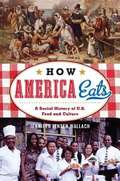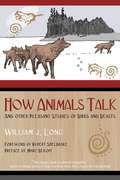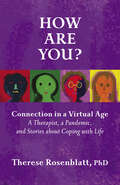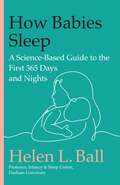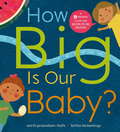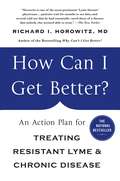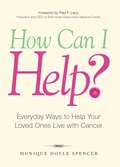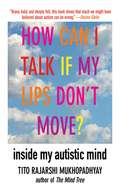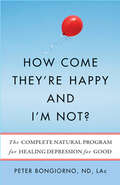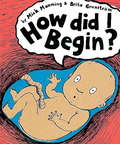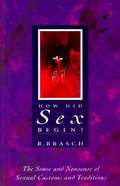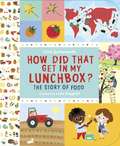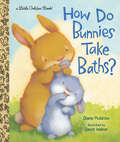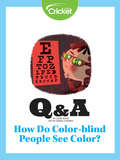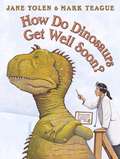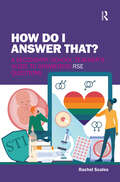- Table View
- List View
House on Fire: The Fight to Eradicate Smallpox
by William H. FoegeA story of courage and risk-taking, House on Fire tells how smallpox, a disease that killed, blinded, and scarred millions over centuries of human history, was completely eradicated in a spectacular triumph of medicine and public health. Part autobiography, part mystery, the story is told by a man who was one of the architects of a radical vaccination scheme that became a key strategy in ending the horrible disease when it was finally contained in India. In House on Fire, William H. Foege describes his own experiences in public health and details the remarkable program that involved people from countries around the world in pursuit of a single objective--eliminating smallpox forever. Rich with the details of everyday life, as well as a few adventures, House on Fire gives an intimate sense of what it is like to work on the ground in some of the world's most impoverished countries--and tells what it is like to contribute to programs that really do change the world.
Houseplants for a Healthy Home: 50 Indoor Plants to Help You Breathe Better, Sleep Better, and Feel Better All Year Round
by Jon VanZileThis A-to-Z guide illuminates the numerous health benefits of 50 common, easy-to-grow houseplants along with detailed care instructions and beautiful illustrations of each plant.With plant-scaped rooms popping up all over Pinterest, style blogs, and home décor magazines, houseplants are the hottest home accessory right now—and for good reason. Plants are a quick and easy way to add life, color, and texture to any indoor space. But houseplants offer so much more than just visual interest to a room. They can purify the air, reduce stress, improve sleep—and much more! Houseplants for a Healthy Home explains the specific health and wellness benefits of 50 common, easy-to-grow, and popular houseplants, while introducing you to new favorites bound to brighten your life. You will find an A-to-Z guide of a variety of the plants that includes a beautiful illustration of each plant, along with the plant’s health benefits and clear, detailed care instructions. Let Houseplants for a Healthy Home lead you to a life in full bloom.
Houses of Horror
by Hans HolzerAn acclaimed ghost hunter and author of Real Hauntings shares real-life stories of hauntings from across America. ”Have you ever come home and wondered what might be lurking up the stairs, in the dark of the corridor where the lights don’t reach and the soft footfalls of the visitor disappear into the thick carpet?” For more than five decades, Hans Holzer has been delving into disturbances from The Other Side. This Vienna-born researcher, the man they call “The Ghost Hunter,” has devoted much of his adult life to tracking those phantom presences that emerge from the shadows when least expected. Whether we call these spectral personages, “ghosts” or “spirits” or “left behinds,” they hover among us, defying easy explanation or dismissal. No one in America has researched these ghostly beings more assiduously or skillfully than Holzer. Indeed, he has been lauded as the most published paranormal investigator of the past century. This collection contains some of his most famous and controversial cases. Houses of Horror takes us deep into history both known and obscure; we encounter accused traitor Aaron Burr and experience the postmortem rustlings of colonial spies. In New Hampshire, a nineteenth century admiral makes things go bump in the night; a girl ghost playfully leaves surprise gifts in an old Kentucky home; and in Illinois, a suicide moves restlessly from room to room. Holzer’s explorations in the seemingly unexplainable have taken him far afield. He ventures down dark corridors in eerie New England mansions and sprawling Southern homes. His ghostly quarry surfaces in Minnesota, the rural Midwest heartland; even in Hollywood and on a moving Swiss train. Ever observant, patiently curious, Holzer jots down the cases and then moves on. This rich collection of hauntings can be read as an extended glimpse into the life beyond life; the realm of the unknown.
Housing and Asthma
by Stirling HowiesonAsthma is on the rise in a number of countries, in this volume Howieson asks what role the built environment has to play and what the construction industry can do to either slow the increase or reverse the trend. Based on the findings of a six-year research project, this book considers all aspects of housing to develop new strategies for dealing with the asthma pandemic in Britain and beyond. With the focus on the design and use pattern of our dwellings, the book looks at tackling the problems inherent in existing housing as well as forging guiding principles for the design of new dwellings, together with a financial assessment of the proposals.
Housing, Homelessness, and Social Policy in the Urban North
by Julia Christensen Sally Carraher Travis Hedwig Steven ArnfjordHousing, Homelessness, and Social Policy in the Urban North brings together leading scholars on northern urban housing across the Canadian North, Alaska, and Greenland. Through various case studies, the contributors examine the ways in which housing insecurity and homelessness provide a critical lens on the social dimensions of northern urbanization. They also present key considerations in the development of effective and sustainable social policy for these areas. The book kickstarts a conversation between multiple stakeholders from different cultural and national regions across the North American north. It asks key questions including these: What are the common problems of, and responses to, housing insecurity and homelessness across these northern regions? Is a single definition of “homelessness” even possible, or desirable? And if not, can a shared language around how to end the housing crisis and homelessness in our northern regions still occur? The contributors explore how experiences of northern towns and cities inform an overall understanding of urban forms and processes in the contemporary world, and speak directly to the emerging body of literature on cities. Highlighting key limitations to federal, state, and provincial policy, Housing, Homelessness, and Social Policy in the Urban North raises important implications for developing policy that is responsive to northern realities.
How About Demons?: Possession and Exorcism in the Modern World (Folklore Today #No.467)
by Felicitas D. GoodmanThe author of the Exorcism of Anneliese Michel &“is to be commended for a stimulating and wide-reaching treatment of a compelling and much-debated subject&” (Journal of Folklore Research). As part of a series that strives to introduce new or previously unrecognized folkloric phenomena—as well as new approaches and theories that result from discovery and investigation—How About Demons? provides an overview of a topic that has for many years captured the imagination of people from all walks of life. Rich in detail derived from the author&’s fieldwork and anthropological literature, this work contemplates possession and exorcism in a holistic manner—discussing their effects on both the body and soul. How About Demons? paints a picture of possession as a usually positive experience occurring in a wide variety of cultures and religions around the globe. It also details the ritual of exorcism which is applied when things go wrong. &“Quite an interesting book.&”—Religious Studies Review &“It is by far superior to anything else on demons we have seen in the past few years.&”—The American Rationalist
How America Eats: A Social History of U. S. Food and Culture (American Ways)
by Jennifer Jensen Wallach<p><i>How America Eats: A Social History of U.S. Food and Culture</i>, by food and social historian Jennifer Wallach, sheds a new and interesting light on American history by way of the dinner table. It is, at once, a study of America's diverse culinary history and a look at the country's unique and unprecedented journey to the present day. While undeniably a "melting pot" of different cultures and cuisines, America's food habits have been shaped as much by technological innovations and industrial progress as by the intermingling and mixture of ethnic cultures. By studying what Americans have been eating since the colonial era, we are further enlightened to the conflicting ways in which Americans have chosen to define themselves, their culture, their beliefs, and the changes those definitions have undergone over time. <p>Understanding the American diet is the first step toward grasping the larger truths, the complex American narratives that have long been swept under the table, and the evolving answers to the question: What does it mean to be American?
How Animals Talk: And Other Pleasant Studies of Birds and Beasts
by William J. Long Marc Bekoff Rupert SheldrakeThe classic and original text that first explored the telepathic methods of communication of wild animals • Based on years of detailed field observations, first published in 1919 • Written by the famous American naturalist who was the first to study telepathy in the wild • Forewords by biologists Rupert Sheldrake, who has spent 15 years researching the unexplained powers of animals, and Marc Bekoff, the editor of the three-volume Encyclopedia of Animal Behavior Many sources have commented on the silent communication abilities of pets, but never before and not since the first publication of this book in 1919 has the subject of animal telepathy in the wild been so fully researched. How Animals Talk explores the phenomenon of vocal, silent, and even motionless communication among animals. From crow talk to instant herd communication, author William J. Long theorizes that animals are much more intelligent, emotional, and moral than we have traditionally thought and that their ability to sense the presence of other living beings is an innate ability shared by humans as well. Based on many years of field observations, this classic text contains numerous examples of animal behavior that defy conventional explanation. Long believed in the importance and validity of anecdotal evidence. He recognized the dangers of conventional research in reducing animals to mere numbers and how the cold third-person prose of scientific study can objectify animals, distancing "us" from "them." His findings on the impact of our presence on animal life--and the cost that we pay in separating ourselves from animals, who help define our place in the natural world--may be more relevant today than ever before.
How Are You?: A Therapist, A Pandemic, and Stories about Coping with Life
by Dr. Therese RosenblattA therapist shares her patients&’ experiences—and her own—during the dramatic disruption of the Covid crisis. By turns a memoir, a chronicle, and a provocative contemplation of life in a socially distanced and virtual world, How Are You? tells the story of a therapist plunged overnight into the unsettling reality of a pandemic and all-virtual therapy. Therese Rosenblatt shares her privileged front-row seat into the hearts and minds of her patients, to report on what has gone on inside real peoples&’ heads from the dark, early days of the pandemic through its long, drawn-out progression. Dr. Rosenblatt then trains her attuned eyes and ears onto herself, sharing some of her experiences and challenges—and unexpected pleasures—as she navigates this new world together with her patients. In addition to recounting how her patients are coping with loss, loneliness, and isolation, as well as overcrowding with relatives, spouses, and partners and challenges with substance use, she opens a window into her private thoughts as she conducts her sessions. All the while, she contemplates the specter of catastrophic illness and the move to an existence liberated from the physical space of the consulting room, yet missing its comforts and human sensibilities. Whether addressing difficult marriages, ambivalence about pregnancy, or young adults trying to launch into the world while locked down with their parents, Dr. Rosenblatt offers insight gleaned from twenty-six years of practice—and explores in depth this historic event&’s psychological effects on us as individuals.
How Babies Sleep: A Science-Based Guide to the First 365 Days and Nights
by Helen L. BallFrom a pioneering infant sleep researcher, this book is a salvation for parents of newborns trying to maintain a nighttime routine. Over the past century and a half, we have tried to manipulate baby sleep to fit with the rapidly changing nature of adult lives. The mismatch we have created with our babies&’ biology is framed as &‘baby sleep problems&’, and infants are often &‘treated&’ using behavioural and clinical interventions. But it is not baby sleep that needs fixing—only our understanding of it. In How Babies Sleep, Helen Ball brings together cutting-edge science, anthropological insight, and practical advice to provide parents with everything they need to help them confidently—and sanely—navigate the first 365 night-times with a new baby. It will teach you how to harmonise your needs with those of your infant, and empower you to reject approaches that make you uncomfortable. Feel confident in a strategy that works for you and your family!
How Big is Our Baby?: A 9-month guide for soon-to-be siblings
by Smriti Prasadam-HallsWhen a new baby is on the way, siblings-to-be have lots of feelings and plenty of questions. But whether they're impatient, curious or a little worried, this friendly and reassuring guide explains each step of the pregnancy journey and helps little ones feel involved and excited. With a month-by-month approach that compares the size of the growing baby to something familiar to the young reader, such as a speck of sand at the seaside or an egg, readers also find out about how Baby is developing, from when the heart might first beat to when they'll be able to feel it kick. The book also includes information about how life might change once Baby arrives, and how exciting it will be to have a new baby brother or sister.
How Can I Get Better?: An Action Plan for Treating Resistant Lyme & Chronic Disease
by Richard HorowitzAN INSTANT NATIONAL BESTSELLER!“Horowitz is one of the most prominent ‘Lyme literate’ physicians…patients wait for months to see him, and several told me that he had essentially cured them of a disease that nobody else seemed able to treat.” —The New Yorker“If you have suffered from unexplained, chronic or hard-to-treat illness, this book is your pathway to health.” —Mark Hyman, #1 New York Times bestselling author of The Blood Sugar Solution on Why Can’t I Get Better?From Dr. Richard I. Horowitz, one of the country's foremost doctors, comes a ground-breaking book about diagnosing, treating and healing Lyme, and peeling away the layers that lead to chronic disease.Are you sick, but can’t find any answers why? Do you have a seemingly unconnected collection of symptoms that leave doctors guessing? Or have you been diagnosed, but found that none of the treatments seems to make a difference? You may have Lyme disease and not even know it. Known as “the great imitator,” Lyme disease and its associated co-infections can mimic the symptoms of and often be misdiagnosed as Chronic Fatigue Syndrome, fibromyalgia, rheumatoid arthritis, lupus, multiple sclerosis, and even depression, anxiety, obsessive-compulsive disorder, and psychosis. In his landmark book, Why Can’t I Get Better?: Solving the Mystery of Lyme & Chronic Disease, renowned internist and leading world expert Dr. Horowitz introduced his revolutionary plan for treating Lyme disease, and chronic diseases in general. Now, in this new handbook How Can I Get Better?, Dr. Horowitz updates his research and offers a direct, actionable step-by-step plan for implementing his 16 MSIDS Diagnostic Map.You will find:*The latest pertinent information on the most important scientific discoveries *Emerging research on bacterial “persisters”—bacteria that can survive antibiotics—and new therapies to get rid of them*A seven-step action plan that patients and doctors can follow to ensure better health.
How Can I Help?
by Monique Doyle SpencerWhen a loved one is diagnosed with cancer, it is often difficult to know what to do. Those who want to help can sometimes make matters worse. Written in a frank conversational manner, this book offers readers specific advice on what to do for a friend or loved one in need, such as offer to do the weekly grocery shopping, pick up the kids from school or bring them to practice, choose to be a chemobuddy, and keep up with bills and other important deadlines. This stressful and uncertain time is difficult for the patient's family and friends. This book provides the support and guidance everyone needs to make this time easier.
How Can I Help?
by Monique Doyle Spencer Paul F LevyWhen a loved one is diagnosed with cancer, it is often difficult to know what to do. Those who want to help can sometimes make matters worse. Written in a frank conversational manner, this book offers readers specific advice on what to do for a friend or loved one in need, such as offer to do the weekly grocery shopping, pick up the kids from school or bring them to practice, choose to be a chemobuddy, and keep up with bills and other important deadlines. This stressful and uncertain time is difficult for the patient's family and friends. This book provides the support and guidance everyone needs to make this time easier.
How Can I Help?: Everyday Ways to Help Your Loved Ones Live with Cancer
by Monique Doyle SpencerWhen a loved one is diagnosed with cancer, it is often difficult to know what to do. Those who want to help can sometimes make matters worse. Written in a frank conversational manner, this book offers readers specific advice on what to do for a friend or loved one in need, such as offer to do the weekly grocery shopping, pick up the kids from school or bring them to practice, choose to be a chemobuddy, and keep up with bills and other important deadlines.This stressful and uncertain time is difficult for the patient's family and friends. How Can I Help? provides the support and guidance everyone needs to make this time easier.
How Can I Talk If My Lips Don't Move?: Inside My Autistic Mind
by Tito Rajarshi MukhopadhyayAn astounding new work by the author of The Mind Tree that offers a rare insight into the autistic mind and how it thinks, sees, and reacts to the world. When he was three years old, Tito was diagnosed as severely autistic, but his remarkable mother, Soma, determined that he would overcome the "problem" by teaching him to read and write. The result was that between the ages of eight and eleven he wrote stories and poems of exquisite beauty, which Dr. Oliver Sacks called "amazing and shocking." Their eloquence gave lie to all our assumptions about autism. Here Tito goes even further and writes of how the autistic mind works, how it views the outside world and the "normal" people he deals with daily, how he tells his stories to the mirror and hears stories back, how sounds become colors, how beauty fills his mind and heart. With this work, Tito-whom Portia Iversen, co-founder of Cure Autism Now, has described as "a window into autism such as the world has never seen"-gives the world a beacon of hope. For if he can do it, why can't others? "Brave, bold, and deeply felt, this book shows that much we might have believed about autism can be wrong."-Boston Globe
How Come They're Happy and I'm Not?: The Complete Natural Program for Healing Depression for Good
by Peter BongiornoA proven, science-based, holistic approach to beating depression and feeling good—without medication—from the author of Put Anxiety Behind You. For many people who suffer from depression and anxiety, prescription drugs have either not been effective or have produced intolerable side effects. Now, naturopathic doctor and acupuncturist Peter Bongiorno, ND, LAc, offers a drug-free approach for healing depression in How Come They&’re Happy and I&’m Not. Bongiorno explains that depression and chronic low moods often have roots in physical ailments: inflammation, digestive problems, poor nutrient absorption, or disease. Depression can also be brought on by spiritual concerns, life events, or simply insufficient resources in dealing with day-to-day stress. Bongiorno&’s integrative, natural approach to psychology and healing, which he has used successfully with his own patients, features a personalized approach that includes: Working with your doctor to identify underlying causes of depression with blood tests and dietary changesBotanical medicines, yoga, massage, and acupuncture pointsA treatment plan based on your particular symptoms and circumstances
How Did I Begin?
by Mick ManningIf you choose to share 'the facts of life' with children at a young age, this is the perfect book to do so. It gently guides the reader through each stage of a child's development within the womb with charming illustrations and simple explanations, inviting lots of discussion and providing answers to all those questions. Shortlisted for the Junior Science Book Award (now the Royal Society's Science Prize).
How Did Sex Begin?
by R. BraschWitty, candid investigation of the myths, traditions and practices surrounding this most popular of human pursuits, originally published in Australia in 1973. The author has written 30 books including 'How did Sport Begin?' and 'There's a Reason for Everything'. He is a scholar in the fields of theology, philosophy and history and was awarded the Media Peace prize in 1979.
How Did That Get in My Lunchbox? The Story of Food
by Chris ButterworthFresh retro artwork lures little readers on a tasty trip to farms, dairies, and more. Yum! The best part of a young child's day is often opening a lunchbox and diving in. But how did all that delicious food get there? Who made the bread for the sandwich? What about the cheese inside? Who plucked the fruit? And where did the chocolate in that cookie get its start? From planting wheat to mixing flour into dough, climbing trees to machine-squeezing fruit, picking cocoa pods to stirring a vat of melted bliss, here is a clear, engaging look at the steps involved in producing some common foods. Healthy tips and a peek at basic food groups complete the menu.
How Do Bunnies Take Baths? (Little Golden Book)
by Diane MuldrowThe perfect book to read before bathtime--a new Little Golden Book about the different ways animals keep themselves clean.Tigers love to soak in a cold lake or stream.Macaques relax in hot water steam!Beavers comb their fur to remove what's cruddy.Rhinos roll around in a bath that's muddy!This delightful rhyming Little Golden Book shares fun facts about how bunnies, zebras, cats, elephants, and many other animals keep themselves clean. Young boys and girls will love comparing their bathtime to those of the adorable animals in this new book from New York Times bestselling author Diane Muldrow (Everything I Need to Know I Learned From a Little Golden Book series) and beloved illustrator David Walker (How Do Penguins Play?, Bears on Chairs).
How Do Color-blind People See Color?
by Lizzie WadeTo understand what it means to be color-blind, you must first understand how most of us see color.
How Do Dinosaurs Get Well Soon?
by Jane YolenWhat if a dinosaur catches the flu? Does he whimper and whine between each "At-choo"? Does he drop dirty tissues all over the floor? Does he fling his medicine out of the door? Just like kids, little dinosaurs hate being sick. And going to the doctor can be pretty scary. How DO dinosaurs get well soon? They drink lots of juice, and they get lots of rest; they're good at the doctor's, 'cause doctors know best. From enormous sneezes to gigantic wails, the outrageous antics of the mischievous young dinosaurs in this book are sure to bring laughter to anyone who has ever said "Atchoo!"
How Do I Answer That?: A Secondary School Teacher's Guide to Answering RSE Questions
by Rachel ScalesWhen it comes to those difficult questions about sex and relationships, how do you strike the balance between an answer that is professional but open, correct but doesn’t create panic? Aimed at secondary teachers and trainees, as well as being useful for parents and those working in charities and the voluntary sector, this book covers all the mandatory topics of the new RSE curriculum. Each chapter includes a full list of the questions to be tackled, teacher guidance highlighting important points, and model answers. Diagrams and photos are included to aid understanding and there is helpful signposting to further reading. Potentially unfamiliar topics, such as laws surrounding sexting and LGBTQ+ terminology, are clearly explained and common misconceptions and myths are dispelled.Based on years of experience, this handy text provides clear answers to the questions young people ask about RSE to help you increase your knowledge, gain confidence and ensure pupils receive the most accurate and up to date information.
How Do I Grow?
by Robert CarolaAll children have curiosity about their bodies and how they work. Here are simple, straightforward answers to the how, what and why questions children ask.
